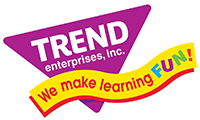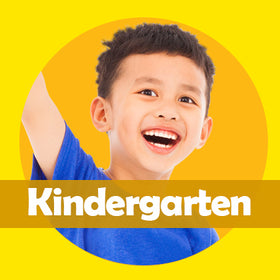
5 Ways to Improve Reading Skills for 1st Graders at Home
Reading opens a whole world of possibilities! Learning to read is a very exciting time for 1st graders that can give them feelings of accomplishment and independence.
Reading takes practice to master. It can be intimidating for kids, and it can be difficult for parents to know how to reinforce reading skills at home. We’re here to help! Making reading practice FUN for kids is essential for literacy success and helps everyone (parents included) stick with it.
Help kids hone their reading skills at home with lots of FUN practice activities. We’ve listed 5 ways to provide at-home reading help for 1st graders, plus our favorite products for building reading skills and fluency from first grade and beyond.
1. Make reading a priority.
Give reading the importance it deserves by incorporating it into your daily routine, beyond what is necessary for schoolwork.
- Bedtime usually has its own routine and might be the ideal time to incorporate reading into each day. If bedtime reading isn’t an option, that’s OK. Choose another time and work hard to be diligent about keeping it scheduled. Doing so shows how important reading is and helps build solid habits too.
- Take reading to go! Reading Rockets suggests never leaving home without something for your child to read. Wait times before appointments or activities are perfect opportunities to practice reading skills. Bringing your own materials to read, like activity books and flash cards, guarantees you’ll have age-appropriate and interesting materials for your child.
- Prioritize reading for yourself, too. Carve out time for your own personal reading at home. Not only is it enjoyable, it models the value of reading for your child and portrays reading as a “treat” rather than a chore.
- Replace TV time with reading-based activities. Schedule individual reading for the whole family in place watching television. Take time for everyone to retell what they read too. This is a great practice of reading comprehension and listening.
- You can also play skill-building games, such as Match Me® Cards or Bingo games in place of TV time. This is great for a range of ages and players.
2. Spend time reading aloud together.
Let’s read! Bonding together over a book is a great way to create meaningful memories and associate positive experiences with reading and learning. Reading aloud benefits your 1st grader in many ways from fine-tuning fluency and reading comprehension to practicing listening skills.
- Switch up reading sessions to keep your learner engaged and interested. Try different approaches: read a page simultaneously, or alternate pages or paragraphs.
- Listening to a story aloud is important (and FUN!) for early readers. Hearing and seeing the words helps with decoding (matching letter combinations to sounds) and pronunciation. Also, children get to hear your expressions and inflections, which not only makes the story interesting but also helps them learn to read expressively as well.
- Invite children to participate in reading aloud with you during daily tasks, too. This might include reading grocery lists, signs in stores, events on the family calendar, notes and cards, and so on. This is a good way to introduce kids to new vocabulary words they might not regularly encounter, and it’s a great opportunity to practice sounding the words out together.
3. Discuss reading and ask questions.
Encourage young readers to talk about what they’ve read. Prompt discussions by asking kids questions about the story (see examples below).
- Talking about books is fun for kids – they will be excited to tell their favorite parts, surprising events, and so on. Listen patiently as each answer can clue you in to their understanding of the reading materials and ability to comprehend.
- When asking specific questions, it might take new readers a little extra time to construct their answers as these are new skills. Refrain from filling in the gaps for them – you’ll be better able to measure their ability to summarize and retell events.
- Describing books also strengthens verbal communication skills and gives kids practice using vocabulary associated with literature (characters, setting, plot, etc.).
- Don’t forget to applaud their efforts and encourage them to keep up the good work!
Here are samples questions to ask your child before, during, and after reading a story:
Before starting the book:
- Based on the cover, what do you think this story is going to be about?
- What are you excited to find out?
- What’s happening so far in the book?
- What do you think about this character?
- How do you think the character feels?
- How would you feel if you were in the character’s place?
- What do you think this word means, based on the picture shown?
- Why do you think this character became upset?
- What do you think is going to happen next?
After reading:
- What was your favorite part of the book?
- What was the book about?
- Did you learn anything new from the story?
- Did the story/characters remind you of anything/anyone—a book, movie, friend, memory, etc.?
- If you could change the ending, what would you do?
- Why was this book important/meaningful/exciting/boring/etc. to you?
- Metacognitive thinking (i.e. thinking about thinking): actively thinking about the text as they are reading it – “Am I understanding what I’m reading?”
- Predicting: naming what will happen next based on prior knowledge of the subject, the characters, or the child’s own experiences
- Emoting: naming words and phrases that appealed to their senses and suggested feelings
- Summarizing: identifying the main points of the story and naming them in their own words
- Evaluating & Forming opinions: deciding how they feel about the events of the story and the text as a whole
- Communicating: the ability and vocabulary to logically describe different parts of a story, including characters and events
4. Encourage rereading.
Rereading books, whether independently or together, is important in helping your child develop fluency and comprehension, and can even build interest in reading as a hobby.
New text may be challenging due to unfamiliar vocabulary. Children may need to work through sounding out words and decoding the first time (or several times) through a new book and then focus on understanding the story in later reads.
While it may seem redundant to you to reread books, it is a very valuable use of your child’s time! Rereading familiarizes kids with the vocabulary of a story, helping them move through the text accurately and pronounce words correctly. When they do not have to focus on each individual word, they are able to improve their fluency each subsequent time through. Whether silently or aloud – being able to read fluently gives kids a mega confidence boost.
Do you remember your favorite book as a child? Many people do – and it is likely one they read often! Rereading favorite books helps kids bond with the characters, builds a connection with the story, and can spark a love of reading that lasts.
5. Put practice into action!
Look beyond books for active and fun reading practice for your 1st grader. Incorporate games and activities to improve reading skills into game nights and playtime to reinforce learning in enjoyable ways.
There are many types of fun learning materials that provide playful practice and reading help for your 1st grader. Whether you’re looking for a quick study session, on-the-go entertainment, or a family activity, look for language-related flash cards, activity books, and games to suit any occasion.
Store favorite books and reading practice materials in an area where kids have easy access and will be inclined to play with them often. Add new items as your child’s skills grow to keep this area fresh and FUN! We’ve listed some of our favorite learning materials and activities to help improve reading skills below to get you started:
- Rhyming, Sight Words, Initial Consonants Wipe-Off® Bingo
- Sight Words Pocket Flash Cards
- Rhyming Words Match Me® Cards
- Reading Power Pack
- Spellominoes® Challenge Cards®
- Vowels and Vowel Teams Skill Drill Flash Cards
Looking for even more activities to improve reading skills? Browse our free printables and flash cards to work on specific skills, and discover Skillbooks and Wipe-Off® Books to help younger learners prepare to read.





Leave a comment